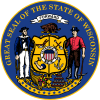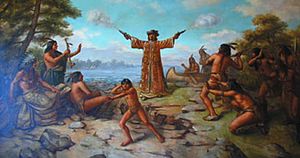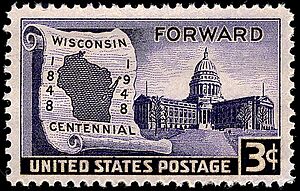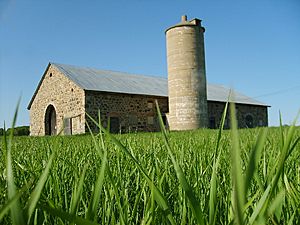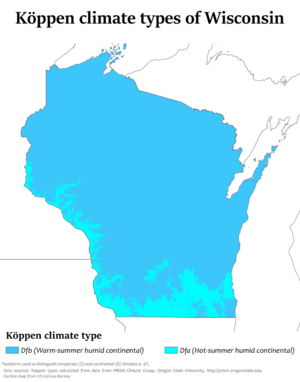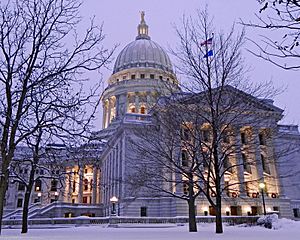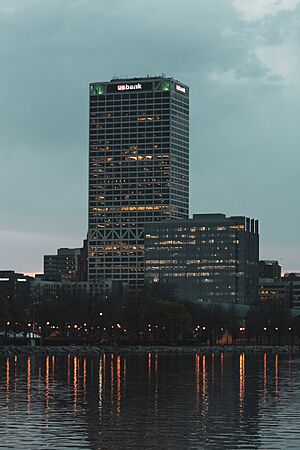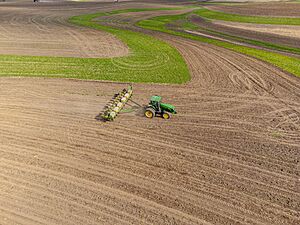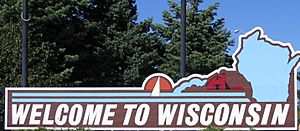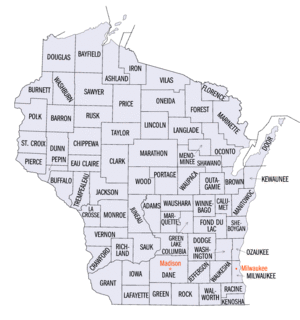Wisconsin facts for kids
Quick facts for kids
Wisconsin
|
|||||||||||||||||||
|---|---|---|---|---|---|---|---|---|---|---|---|---|---|---|---|---|---|---|---|
|
|||||||||||||||||||
| Nicknames:
Badger State, America's Dairyland
|
|||||||||||||||||||
| Motto(s):
Forward
|
|||||||||||||||||||
| Anthem: "On, Wisconsin!" | |||||||||||||||||||

Location of Wisconsin within the United States
|
|||||||||||||||||||
| Country | United States | ||||||||||||||||||
| Before statehood | Wisconsin Territory | ||||||||||||||||||
| Admitted to the Union | May 29, 1848 (30th) | ||||||||||||||||||
| Capital | Madison | ||||||||||||||||||
| Largest city | Milwaukee | ||||||||||||||||||
| Largest county or equivalent | Milwaukee County | ||||||||||||||||||
| Largest metro and urban areas | Milwaukee | ||||||||||||||||||
| Legislature | Wisconsin Legislature | ||||||||||||||||||
| • Upper house | Senate | ||||||||||||||||||
| • Lower house | Assembly | ||||||||||||||||||
| Judiciary | Wisconsin Supreme Court | ||||||||||||||||||
| U.S. senators |
|
||||||||||||||||||
| U.S. House delegation |
|
||||||||||||||||||
| Area | |||||||||||||||||||
| • Total | 65,498.37 sq mi (169,640.0 km2) | ||||||||||||||||||
| • Land | 54,153.1 sq mi (140,256 km2) | ||||||||||||||||||
| Area rank | 23rd | ||||||||||||||||||
| Dimensions | |||||||||||||||||||
| • Length | 311 mi (507 km) | ||||||||||||||||||
| • Width | 260 mi (427 km) | ||||||||||||||||||
| Elevation | 1,050 ft (320 m) | ||||||||||||||||||
| Highest elevation | 1,951 ft (595 m) | ||||||||||||||||||
| Lowest elevation | 579 ft (176 m) | ||||||||||||||||||
| Population
(2024)
|
|||||||||||||||||||
| • Total | |||||||||||||||||||
| • Rank | 20th | ||||||||||||||||||
| • Density | 108.8/sq mi (42.0/km2) | ||||||||||||||||||
| • Median household income | $74,600 (2023) | ||||||||||||||||||
| • Income rank | 21st | ||||||||||||||||||
| Demonym(s) | Wisconsinite, Cheesehead (colloquial) | ||||||||||||||||||
| Language | |||||||||||||||||||
| • Official language | None | ||||||||||||||||||
| • Spoken language |
|
||||||||||||||||||
| Time zone | UTC– 06:00 (Central) | ||||||||||||||||||
| • Summer (DST) | UTC– 05:00 (CDT) | ||||||||||||||||||
| USPS abbreviation |
WI
|
||||||||||||||||||
| ISO 3166 code | US-WI | ||||||||||||||||||
| Traditional abbreviation | Wis., Wisc. | ||||||||||||||||||
| Latitude | 42° 30' N to 47° 05′ N | ||||||||||||||||||
| Longitude | 86° 46′ W to 92° 54′ W | ||||||||||||||||||
|
|||||||||||||||||||
Wisconsin (pronounced wiss-KON-sin) is a state in the Great Lakes area of the Upper Midwest in the United States. It shares borders with Minnesota to the west, Iowa to the southwest, and Illinois to the south. To the east, it borders Lake Michigan, and to the northeast, Michigan. Lake Superior is to its north.
Wisconsin is home to about 6 million people and covers an area of about 65,500 square miles. This makes it the 20th-largest state by population and the 23rd-largest by area. The state has 72 counties. Its biggest city is Milwaukee, and its capital city is Madison, which is also the second-largest city. Other important cities include Green Bay and Kenosha.
The land in Wisconsin is very varied. Much of it was shaped by glaciers during the Ice Age, except for a special area called the Driftless Area. Wisconsin has a long coastline along the Great Lakes. Long ago, Native American groups like the Algonquian and Siouan nations lived here. Today, eleven federally recognized tribes still call Wisconsin home. Wisconsin became a state in 1848. Many European settlers, especially from Germany and Scandinavia, moved here in the 1800s. Their cultures are still a big part of Wisconsin, especially in its food, like bratwurst and kringle.
Wisconsin is famous for its dairy farms and is often called "America's Dairyland." It is especially well-known for its delicious cheese.
Contents
- What Does the Name Wisconsin Mean?
- Wisconsin's Past: A Journey Through Time
- Wisconsin's Diverse Geography
- Who Lives in Wisconsin?
- How Wisconsin's Government Works
- Wisconsin's Economy: What It Makes and Does
- Getting Around Wisconsin
- Important Cities in Wisconsin
- Learning in Wisconsin: Schools and Universities
- Wisconsin's Culture and Fun Activities
- Outdoor Fun and Sports in Wisconsin
- See also
What Does the Name Wisconsin Mean?
The name Wisconsin comes from the Wisconsin River. Native American groups who spoke Algonquian gave the river its name. The first European to see the Wisconsin River was a French explorer named Jacques Marquette in 1673. He wrote the name as Meskousing in his journal.
Over time, French writers changed the spelling to Ouisconsin. When English speakers arrived in the 1800s, they changed it to Wisconsin. The government of Wisconsin Territory made this spelling official in 1845.
The exact meaning of the original Algonquian word is not fully known. Most ideas suggest it has to do with the river and the red sandstone along its banks. One popular idea is that it comes from a word meaning "it lies red," referring to the reddish sandstone cliffs in the Wisconsin Dells. Other ideas suggest it means "red stone place" or "where the waters gather."
Wisconsin's Past: A Journey Through Time
Early People in Wisconsin
For about 14,000 years, many different cultures have lived in Wisconsin. The first people arrived around 10,000 BCE during the Wisconsin Glaciation, a time when glaciers covered much of the land. These early people, called Paleo-Indians, hunted large Ice Age animals like the mastodon.
After the Ice Age ended around 8000 BCE, people in the Archaic period hunted, fished, and gathered wild plants for food. Later, between 1000 BCE and 1000 CE, during the Woodland period, farming societies began to grow. Wisconsin became known for the "Effigy Mound culture," which built thousands of mounds shaped like animals.
Between 1000 and 1500 CE, the Mississippian and Oneota cultures built large villages. One important village was Aztalan in southeast Wisconsin. The Oneota people might be the ancestors of today's Ioway and Ho-Chunk nations. Other Native American groups living in Wisconsin when Europeans arrived included the Menominee, Ojibwa, Sauk, Fox, Kickapoo, and Pottawatomie.
European Explorers and Settlers
The first European to visit Wisconsin was probably the French explorer Jean Nicolet in 1634. He traveled by canoe and is thought to have landed near Green Bay. Other French explorers, Pierre Radisson and Médard des Groseilliers, visited Green Bay again in the 1650s to trade furs with Native Americans.
In 1673, Jacques Marquette and Louis Jolliet were the first to travel the Fox–Wisconsin Waterway all the way to the Mississippi River. French fur traders continued to work in Wisconsin for many years. However, the French did not build permanent settlements until Great Britain took control after the French and Indian War in 1763.
Some French traders, like Charles Michel de Langlade, settled in Wisconsin permanently. The British also focused on the fur trade. In 1791, two free African Americans even set up a fur trading post in Marinette. The first permanent settlers were mostly French Canadians, some English-speaking people, and a few African American freedmen.
Charles de Langlade is often seen as the first permanent settler, moving to Green Bay in 1764. Settlement also began in Prairie du Chien around 1781. The French called Green Bay "La Baye," but British fur traders called it "Green Bay" because the water looked green in spring. This name stuck.
Under British rule, the fur trade in Wisconsin grew a lot. The first self-sustaining farms were also started. Green Bay became a busy community where people grew their own food and held celebrations. The Tank Cottage in Green Bay, built in 1776, is the oldest standing building from Wisconsin's early days.
Becoming a U.S. Territory
Wisconsin became part of the United States after the American Revolutionary War in 1783. It was part of the Northwest Territory and later other territories like Indiana and Michigan. However, the British still controlled the area until after the War of 1812.
Under American control, the economy changed from fur trading to lead mining. Many people from the U.S. and Europe came to mine lead in places like Mineral Point. Some miners lived in the holes they dug, which earned them the nickname "badgers." This is why Wisconsin is called the "Badger State."
The arrival of many miners caused problems with Native American groups. Conflicts like the Winnebago War of 1827 and the Black Hawk War of 1832 led to Native Americans being forced to leave most parts of the state.
The Wisconsin Territory was officially created on April 20, 1836. Soon after, farmers from the New England states settled in the rich farmlands around what is now Milwaukee.
Wisconsin Becomes a State
The Erie Canal made it easier for settlers and immigrants from Europe to come to Wisconsin. Many people from New England and New York moved here. They became important in law and politics, creating rules that affected the Native American and French-Canadian residents. They also started towns, schools, and churches.
At the same time, many Germans, Irish, Norwegians, and other immigrants settled in Wisconsin. They built their own communities and religious institutions.
Wisconsin's population grew quickly. On May 29, 1848, it became the 30th state. Between 1840 and 1850, the non-Native American population jumped from 31,000 to 305,000. More than a third of these people were born in other countries.
Nelson Dewey was Wisconsin's first governor of Wisconsin. He helped the state set up its new government. He also supported building roads, railroads, canals, and improving rivers. Governor Dewey was against the spread of slavery, like many Wisconsin governors after him.
The Civil War and Beyond
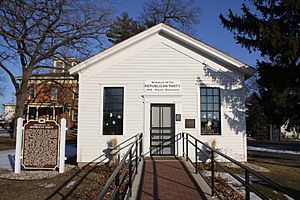
Politics in early Wisconsin were shaped by the national debate over slavery. Wisconsin was a free state from the start and became a center for people who wanted to end slavery. In 1854, a runaway slave named Joshua Glover was captured in Racine. However, a group of people who opposed slavery helped him escape to Canada.
The Wisconsin Supreme Court later said that the law allowing runaway slaves to be captured was against the constitution. The Republican Party, which was against the spread of slavery, was founded in Ripon, Wisconsin, on March 20, 1854. This party soon became very strong in Wisconsin politics.
During the Civil War, about 91,000 soldiers from Wisconsin fought for the Union.
Growing the Economy

Wisconsin's economy changed a lot in its early years. Lead mining became less important, and farming became a main activity in the southern part of the state. Railroads were built to carry grain to markets. Companies like J.I. Case & Company in Racine started making farm equipment. For a short time in the 1860s, Wisconsin was a top producer of wheat.
In northern Wisconsin, the lumber industry was very important. Sawmills appeared in cities like La Crosse and Eau Claire. However, these activities caused environmental problems. By the late 1800s, intense farming had hurt the soil, and most of the state's forests were cut down. This led to a decline in wheat farming and the lumber industry.
Starting in the 1890s, farmers in Wisconsin began to focus on dairy production instead of wheat. Many immigrants brought their cheese-making skills. With good land and research from the University of Wisconsin, the state became known as "America's Dairyland."
Also, people like Aldo Leopold helped replant the state's forests in the early 1900s. This helped the lumber and paper mill industries become more sustainable. It also encouraged tourism in the northern forests. Manufacturing also grew quickly in Wisconsin, with many immigrants working in factories. Cities like Milwaukee made everything from beer to heavy machinery. By 1910, Wisconsin was the 8th largest state in total product value.
The 20th Century and Beyond

The early 1900s saw the rise of progressive politics in Wisconsin, led by Robert M. La Follette. Between 1901 and 1914, Wisconsin created the first statewide primary election system, a law to help workers injured on the job, and the first state income tax. The "Wisconsin Idea" also helped expand the University of Wisconsin across the state. Later, Wisconsin created the first unemployment compensation program in the U.S. in 1932.
Wisconsin During World War I
During World War I, Wisconsin faced challenges. Because many people, including German immigrants and some politicians, wanted to stay neutral, Wisconsin was sometimes called the "Traitor State" by others.
Robert M. La Follette, a leader against the war, tried to stop a bill that would arm merchant ships. Even so, many Wisconsinites supported the war once it began. Businesses, workers, and farms all benefited. Wisconsin was the first state to report for the national military drafts.
The Cold War Era
After World War II, people in Wisconsin had different ideas about the United Nations and the growth of the Soviet Union. But as the world divided into Communist and capitalist sides, public opinion shifted to supporting democracy against Communist expansion.
Wisconsin saw some extreme political events in the mid-1900s. This included the anti-communist actions of Senator Joseph McCarthy in the 1950s. Later, there were strong anti-war protests at UW-Madison, which included the Sterling Hall bombing in 1970.
The state's economy also changed. Heavy industry and manufacturing became less important. Instead, the economy grew in areas like medicine, education, farming businesses, and tourism.
Wisconsin's Diverse Geography
Wisconsin is bordered by the Montreal River, Lake Superior, and Michigan to the north. To the east is Lake Michigan, to the south is Illinois, and to the southwest and northwest are Iowa and Minnesota. The state's borders also include the Mississippi River and St. Croix River in the west, and the Menominee River in the northeast.
With its location between the Great Lakes and the Mississippi River, Wisconsin has many different land features. The state is divided into five main regions:
- The Lake Superior Lowland in the north, along Lake Superior.
- The Northern Highland to the south, with large forests and thousands of lakes. This is where Timms Hill, the state's highest point, is located.
- The Central Plain in the middle, known for unique sandstone formations like the Dells of the Wisconsin River and rich farmland.
- The Eastern Ridges and Lowlands in the southeast, where many of Wisconsin's largest cities are found.
- The Western Upland in the southwest, a rugged area with forests and farms, including bluffs along the Mississippi River. This area is part of the Driftless Area, which was not covered by glaciers during the last Ice Age.
Overall, 46% of Wisconsin's land is covered by forest. Wisconsin also has "sister-state" relationships with regions in Germany, Japan, Mexico, China, and Nicaragua.
Wisconsin's Climate and Weather
Most of Wisconsin has a warm-summer humid continental climate. This means it has warm summers and cold, snowy winters. The highest temperature ever recorded in Wisconsin was 114 °F (46 °C) in the Wisconsin Dells in 1936. The lowest was -55 °F (-48 °C) in Couderay in 1996.
Wisconsin gets a lot of snow. Southern parts of the state average about 40 inches (100 cm) of snow each year. Areas near Lake Superior can get up to 160 inches (400 cm) annually.
Who Lives in Wisconsin?
The United States Census Bureau estimated Wisconsin's population to be about 5.8 million people in 2019. This was a 2.4% increase since the 2010 census. Most of this growth came from more births than deaths.
Wisconsin has always been home to many different groups of people. After the French fur traders, the next settlers were miners, many from Cornwall. Then came "Yankees," people of English descent from New England. They became leaders in business, politics, and education.
Between 1850 and 1900, many immigrants came from Germany, Scandinavia (especially Norway), Ireland, and Poland. In the 20th century, African Americans and Mexicans moved to cities like Milwaukee. After the Vietnam War, many Hmong people also settled in Wisconsin.
Different ethnic groups settled in different parts of the state. German immigrants were mostly in Milwaukee. Norwegian immigrants settled in the north and west, in areas with lumber and farms. Irish, Italian, and Polish immigrants mainly moved to cities. Menominee County is the only county in the eastern U.S. where Native Americans are the majority.
Most of Wisconsin's African-American population lives in four cities: Milwaukee, Racine, Beloit, and Kenosha. Milwaukee is home to almost three-fourths of the state's black Americans. About 33% of Wisconsin's Asian population is Hmong, with large communities in many cities.
In 2018, most of Wisconsin's immigrants came from Mexico, India, China, Laos, and the Philippines.
Religion in Wisconsin
| Religion in Wisconsin (2014) | ||||
|---|---|---|---|---|
| religion | percent | |||
| Protestant | 44% | |||
| Catholic | 25% | |||
| Unaffiliated | 25% | |||
| Jewish | 1% | |||
| Eastern Orthodox | 1% | |||
| Jehovah's Witness | 1% | |||
| Islam | 1% | |||
| Other faith | 1% | |||
Christianity is the main religion in Wisconsin. In 2014, 81% of Wisconsin residents were Christian. This included 50% Protestant and 29% Catholic. About 15% of people said they were not affiliated with any religion.
The Catholic Church has the most members in Wisconsin. Other large Christian groups include the Evangelical Lutheran Church in America and the Lutheran Church–Missouri Synod. The Wisconsin Evangelical Lutheran Synod has its main office in Waukesha, Wisconsin.
How Wisconsin's Government Works
The Constitution of Wisconsin explains how the state government is set up. It has three main parts: the executive, legislative, and judicial branches. The Wisconsin Blue Book is a book published every two years that tells you about the state's government and politics.
State Government Leaders
The executive branch is led by the Governor of Wisconsin. The governor can say "no" to (veto) bills passed by the state legislature. They can also veto specific parts of spending bills. The lieutenant governor takes over if the governor leaves office. Other elected officials include the secretary of state, treasurer, and attorney general.
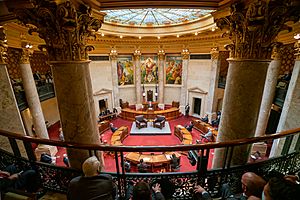
The Wisconsin State Legislature makes the state's laws. It has two parts: the Wisconsin State Assembly and the Wisconsin State Senate. The Assembly has 99 members, and the Senate has 33 members. All members of the Assembly are elected for two-year terms. Senate members are elected for four-year terms. There are no limits on how many terms they can serve.
Wisconsin's court system has four levels. Municipal courts handle local issues. The circuit courts are the main trial courts for civil and criminal cases. Challenges to these rulings go to the Wisconsin Court of Appeals. The highest court is the Wisconsin Supreme Court. This court hears appeals and helps manage the state's court system.
Wisconsin's Economy: What It Makes and Does
In 2019, Wisconsin's total economic output was about $349 billion. The state's economy relies on manufacturing, agriculture, and health care. Manufacturing alone produced $48.9 billion in 2008, making it the tenth largest in the U.S. Manufacturing makes up about 20% of Wisconsin's economy, which is the third highest percentage among all states.
In 2008, the average income per person was $35,239. In March 2017, the unemployment rate was 3.4%. Since 2009, Wisconsin's minimum wage has been $7.25, the same as the federal rate.
Some of the largest employers in Wisconsin include Walmart, the University of Wisconsin–Madison, and Milwaukee Public Schools.
Farming and Food in Wisconsin
Wisconsin is a huge producer of dairy products. It makes about a quarter of all the cheese in America, making it the top state for cheese production. It is also second in milk production, after California. Wisconsin is second in butter production, making about one-quarter of the nation's butter.
The state is also number one in growing corn for silage, cranberries, ginseng, and snap beans for processing. It grows more than half of the country's cranberries and 97% of its ginseng. Wisconsin also produces a lot of oats, potatoes, carrots, tart cherries, maple syrup, and sweet corn. The importance of farming in Wisconsin is shown by the pictures of a cow, an ear of corn, and a wheel of cheese on Wisconsin's state quarter.
A big part of Wisconsin's manufacturing is food processing. Well-known brands like Oscar Mayer and Johnsonville brats are made here. Kraft Foods employs over 5,000 people in the state. Milwaukee is also famous for beer.
| Badger State | |
| State animal: | Badger |
| State Domesticated Animal: |
Dairy cow |
| State Wild Animal: | White-tailed deer |
| State beverage: | Milk |
| State Dairy Product: | Cheese |
| State Fruit: | Cranberry |
| State Bird: | Robin |
| State Capital: | Madison |
| State Dog: | American water spaniel |
| State pro football team: | Green Bay Packers |
| State pro baseball team: | Milwaukee Brewers |
| State pro basketball team: | Milwaukee Bucks |
| State pro hockey team: | Milwaukee Admirals |
| State Fish: | Muskellunge |
| State Flower: | Wood violet |
| State Fossil: | Trilobite |
| State Grain: | Corn |
| State Insect: | European honey bee |
| State Motto: | Forward |
| State Song: | "On, Wisconsin!" |
| State Tree: | Sugar maple |
| State Mineral: | Galena (Lead sulfide) |
| State Rock: | Red granite |
| State Soil: | Antigo silt loam |
| State Dance: | Polka |
| State Symbol of Peace: |
Mourning dove |
| State microbe | Lactococcus lactis |
| State Pastry: | Kringle |
Manufacturing and Goods
Wisconsin has a large and varied manufacturing industry. It focuses on transportation and capital equipment. Big companies like Kohler Company, Mercury Marine, Rockwell Automation, and Harley-Davidson are based here.
Wisconsin is also a top producer of paper, packaging, and other consumer goods. Companies like S. C. Johnson & Son are in the state. Wisconsin ranks first in the country for paper products. The lower Fox River alone has 24 paper mills along its 39-mile stretch.
The development of health care devices and software is a growing part of the state's economy. Companies like GE Healthcare and Epic Systems are important players in this field.
Tourism in Wisconsin
Tourism is a very important industry in Wisconsin, ranking as the state's third largest. Many people visit attractions like the House on the Rock and the Circus World Museum. Festivals such as Summerfest and the EAA Oshkosh Airshow attract visitors from all over the world.
With many lakes and rivers, water recreation is very popular. The northern part of the state, once focused on timber, is now a popular vacation spot. People enjoy hunting, fishing, and exploring nature.
The unique Door Peninsula is a major tourist spot. It draws over two million visitors each year to its charming villages, cherry picking, and fish boils.
Getting Around Wisconsin
Airports and Buses
Wisconsin has eight commercial airports and many smaller airports for general aviation. Milwaukee Mitchell International Airport is the largest international airport in the state.
Many bus companies provide service across Wisconsin, connecting 71 stops in 53 cities. These include Amtrak Thruway, Badger Bus, Flixbus, and Greyhound Lines.
Highways and Trains
The Wisconsin Department of Transportation plans and maintains the state's highways. Eight Interstate Highways run through Wisconsin.
Amtrak offers daily passenger train service between Chicago and Milwaukee with its Hiawatha Service. The Empire Builder also provides cross-country service with stops in Wisconsin. Metra's Union Pacific North line ends in Kenosha, which is the only Metra station in Wisconsin. The Hop, a modern streetcar system, started in Milwaukee in 2018 and is expected to expand.
Important Cities in Wisconsin
More than 68% of people in Wisconsin live in cities. The Greater Milwaukee area is home to about one-third of the state's population. With over 590,000 residents, Milwaukee is the 30th-largest city in the U.S. The chain of cities along Lake Michigan is sometimes called a megalopolis.
Madison, with nearly 260,000 residents, is often ranked as one of the best cities to live in. It is also the fastest-growing city in Wisconsin.
Many medium-sized cities are spread across the state, surrounded by farms. In 2011, there were 12 cities in Wisconsin with populations of 50,000 or more.
Wisconsin has three types of local governments: cities, villages, and towns. Cities and villages are incorporated urban areas. Towns are smaller, unincorporated areas within counties that have limited self-government.
|
Largest cities or towns in Wisconsin
|
||
|---|---|---|
| Rank | Name | Pop. |
| 1 | Milwaukee | 577,222 |
| 2 | Madison | 269,840 |
| 3 | Green Bay | 107,395 |
| 4 | Kenosha | 99,986 |
| 5 | Racine | 77,816 |
| 6 | Appleton | 75,644 |
| 7 | Waukesha | 71,158 |
| 8 | Eau Claire | 69,421 |
| 9 | Oshkosh | 66,816 |
| 10 | Janesville | 65,615 |
Learning in Wisconsin: Schools and Universities
Wisconsin was a leader in developing state universities after the Civil War. By the early 1900s, education in the state followed the "Wisconsin Idea." This idea focused on universities serving the people of the state. It was a big part of the Progressive movement in colleges at the time.
Today, public higher education in Wisconsin includes the 26-campus University of Wisconsin System. Its main university is the University of Wisconsin–Madison. There is also the 16-campus Wisconsin Technical College System. Private colleges and universities include Beloit College, Marquette University, and Milwaukee School of Engineering.
Wisconsin's Culture and Fun Activities

People from Wisconsin are called Wisconsinites. Because of the state's strong history in dairy farming and cheesemaking, people sometimes call Wisconsinites "cheeseheads." There are even "cheesehead hats" made of yellow foam shaped like cheese!
Many ethnic festivals are held across Wisconsin to celebrate the different backgrounds of its citizens. These include Summerfest, Oktoberfest, Polish Fest, and Irish Fest. There are also unique festivals like Brat(wurst) Days and Cheese Days.
Art and Music in Wisconsin
Music Scene
Wisconsin hosts many music festivals. Some popular ones are Eaux Claires, Country Fest, and the Hodag Country Festival. Milwaukee is home to Summerfest, which is called "The World's Largest Music Festival." It takes place every year by the lake. The Wisconsin Area Music Industry also holds an annual awards show for top Wisconsin artists.
Architecture and Art
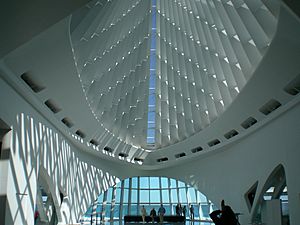
The Milwaukee Art Museum is famous for its unique architecture, especially its moving sunshade designed by Santiago Calatrava. Monona Terrace in Madison is a convention center designed by Anthony Puttnam, based on an idea by Wisconsin native Frank Lloyd Wright. Wright's home and studio, Taliesin, is in Spring Green. It is still an architectural office and school today.

When people from northern Europe moved to Wisconsin, they brought their skills in building Log homes.
Outdoor Fun and Sports in Wisconsin
Wisconsin's varied landscape makes it a popular place for outdoor activities. In winter, people enjoy skiing, ice fishing, and snowmobile races. Wisconsin has many lakes and rivers, with over 11,000 square miles of water. This is more than all but three other states. The Wisconsin Shipwreck Coast National Marine Sanctuary in Lake Michigan protects many historic shipwrecks.
Outdoor activities like hunting and fishing are very popular. The whitetail deer is a common game animal. Each year, over 600,000 deer-hunting licenses are sold in Wisconsin.
Wisconsin's Sports Teams
Wisconsin has major league teams in football, baseball, and basketball. Lambeau Field in Green Bay, Wisconsin, is home to the National Football League's Green Bay Packers. The Packers have been in the NFL since 1921 and have won the most NFL titles, earning Green Bay the nickname "Titletown USA." The Packers are unique because they are the only NFL team owned by their fans across the state. They have won 13 NFL championships, including four Super Bowls. Many people want season tickets to Lambeau Field, with a waiting list of 81,000 people!
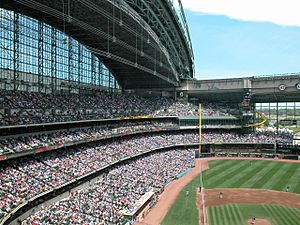
The Milwaukee Brewers are Wisconsin's only major league baseball team. They play at American Family Field in Milwaukee. In 1982, the Brewers won the American League Championship. Before the Brewers, Milwaukee had other baseball teams, including the Braves, who won the World Series in 1957.
The Milwaukee Bucks of the National Basketball Association play at the Fiserv Forum. The Bucks won the NBA Championship in 1971 and 2021.
Wisconsin also has minor league teams in hockey (the Milwaukee Admirals) and baseball (the Wisconsin Timber Rattlers and Beloit Sky Carp). There are also two American Association of Professional Baseball teams and nine Northwoods League teams, which are collegiate all-star summer leagues. Green Bay also has an indoor football team, the Green Bay Blizzard. The state is home to the Milwaukee Wave, a seven-time indoor soccer champion.
Forward Madison FC is a professional soccer team in Wisconsin that plays in the USL League One.
Wisconsin has many college sports programs too. The Wisconsin Badgers are well-known, especially their football team, which has won three Rose Bowl championships. The Badgers men's basketball team won a national title in 1941 and reached the Final Four several times. In 2006, both the men's and women's hockey teams won national titles.
The Marquette Golden Eagles men's basketball team won the NCAA National Championship in 1977.
Many other schools in the University of Wisconsin system compete in the Wisconsin Intercollegiate Athletic Conference. This conference is very successful, with many national championships in different sports.
Wisconsin is home to the world's oldest working racetrack, The Milwaukee Mile, in West Allis, Wisconsin. It has held races even before the Indy 500. Kenosha has the nation's oldest working velodrome, where races have been held every year since 1927.
Sheboygan is home to Whistling Straits golf club, which has hosted major golf championships like the PGA Championship and the Ryder Cup. In 2017, Erin Hills hosted the U.S. Open.
See also
 In Spanish: Wisconsin para niños
In Spanish: Wisconsin para niños



